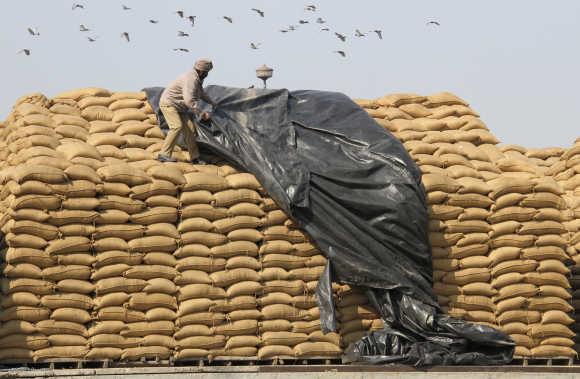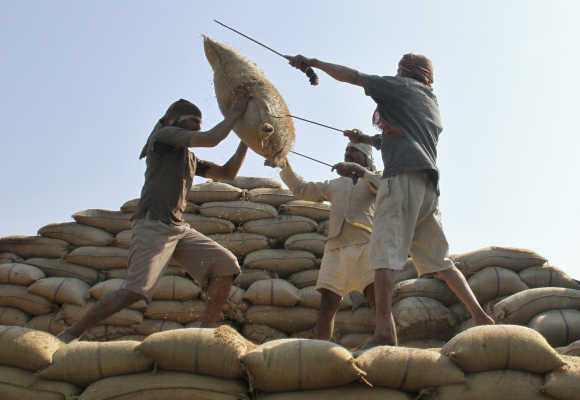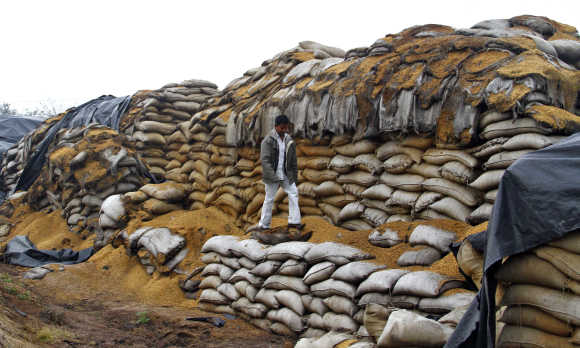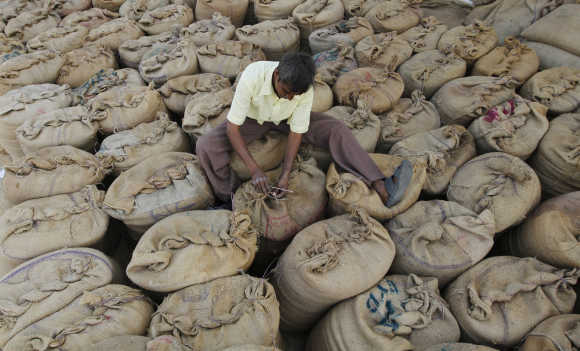 | « Back to article | Print this article |
India's foodgrain stock to rise but much will rot
Too much grain, and no way to distribute it.
In about a month from now, the country's ever-bulging foodgrain stockpile will bloat further to over 75 million tonnes, a record amount.
This will be nearly two-and-a-half times the stipulated maximum food buffer. Worse, it will outstrip the available warehousing capacity (covered and open) of 63 million tonnes by a wide margin.
Even today, a good part of the present food inventory of over 53 million tonnes is lying in the open, under fragile plastic sheets; pakka storage space is only around 45.5 million tonnes.
With over 30 million tonnes more wheat from the fresh crop slated to land up in the Centre's grain kitty in the next four weeks, the problem will only get worse - with the possibility of rot in the monsoon season, and exposure to insects and rats.
Click NEXT to read more...
India's foodgrain stock to rise but much will rot
The hoarding of grain by the government on such a mammoth scale is hard to justify - and is, at the least, an indication that policy has failed.
Meeting the objective of food security is often cited as the purpose for stock-building. Of course, that objective is not going to be met at all unless that hoarded foodgrain is made accessible, physically and economically, to those many Indians who are underfed and malnourished.
Yet, even by estimates from the National Advisory Council, only about 62 million tonnes of grain is needed annually for the implementation of the proposed food security law. Even this is lower than the current level of annual gain procurement, set to exceed 65 million tonnes this year.
Click NEXT to read more...
India's foodgrain stock to rise but much will rot
In any case, given that the food security Bill is still being discussed, the need today is to meet the requirement of the present public distribution system, which has seldom exceeded 55 million tonnes.
The government continues to acquire far more foodgrain than it can distribute through the PDS, leading to the steady increase in the amount of stored foodgrain, turning granaries into grain graveyards.
Such criminal mismanagement of foodgrain cannot be allowed to go on. Food subsidy is skyrocketing because of the heavy costs being incurred on procurement and upkeep of the surplus grain. This strains the exchequer at a time when the government is particularly short of money.
Click NEXT to read more...
India's foodgrain stock to rise but much will rot
Moreover, by cornering the bulk of the post-harvest marketed surplus, the government has distorted the grain market by marginalising trade in the private sector.
Worse, it has skewed the cropping pattern, tilting it in favour of rice and wheat - which have virtually become cash crops thanks to assured marketing and returns.
Meanwhile, pulses and vegetables continue to grow ever more unaffordable. The solution to the unsustainable grain glut lies not so much in the unlimited expansion of storage capacity, as the government is doing, as in cutting down inventories to a manageable and need-based scale.
Click NEXT to read more...
India's foodgrain stock to rise but much will rot
The export of foodgrain is one way to meet this objective. Of course, the scope for exports is limited at present because of adequate supplies in the global grain bazaar.
Offloading stock in the domestic market, even at prices lower than the effective cost of procurement, seems a better and more practical option.
But the most important of all is to revisit the entire gamut of food management policies, including open-ended grain procurement, to end this policy of senseless waste.





